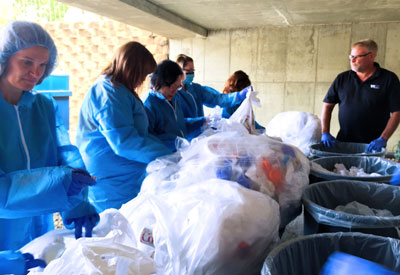Waste Assessments, Sorts, and Tools
Waste Sorts
 A waste sort is the physical sorting of one or more waste streams into a pre-determined set of categories. Sorts are quantitative by nature and can be a good complement to a waste assessment. They can provide pre- and post-test data when implementing a new initiative and, like an assessment, can help with the identification of waste reduction and recycling opportunities.
A waste sort is the physical sorting of one or more waste streams into a pre-determined set of categories. Sorts are quantitative by nature and can be a good complement to a waste assessment. They can provide pre- and post-test data when implementing a new initiative and, like an assessment, can help with the identification of waste reduction and recycling opportunities.
Waste sorts help answer the following questions:
- What’s in the trash?
- Is it consistent day to day?
- What makes up the largest percentage of the trash?
- Are there recyclables or reusables in the trash?
- Are there feasible reduction opportunities?
Waste Assessments
Waste assessments are a high level look at waste. Assessments involve looking at types of waste, overall quantities, and management practices within a facility. They typically involve visual analysis during a facility walk-through and are mainly qualitative in nature. Assessments are a great way to identify opportunities for reduction, improved material management, and cost savings.
MnTAP has created a video to help facilities get started with their own waste assessments. The video, “How to Conduct a Waste Assessment: Tools to Reduce Waste and Save Money at Your Facility,” is a ten minute overview of assessments. A Spanish-language version of the video is also available.
To get started on assessing your solid waste opportunities, check out the Solid Waste Assessment Replication Model, created by a 2015 MnTAP intern as a guide for businesses to conduct their own solid waste assessments and identify reduction, reuse, and recycling opportunities. The model is applicable to any type of business.
Once you’ve gotten started, dive into Solid Waste Reduction at State Agencies, created by a 2014 MnTAP intern to help state agencies establish an effective solid waste management program and to identify projects and practices that can reduce and prevent waste. This in-depth toolkit is a great resource for not only government agencies, but also any facility looking to improve waste management in an office setting.
Other Tools
The Waste Reduction Model (WARM) from U.S. EPA allows users to calculate the greenhouse gas emission reductions from alternative waste management scenarios. The model requires a baseline scenario compared to an alternate scenario.
Greenhouse Gas Equivalencies Calculator from U.S. EPA translates abstract greenhouse gas figures into understandable equivalents, such as “equivalent to avoiding the carbon dioxide emissions of 183,000 cars annually.” This calculator may be useful in communicating your greenhouse gas reduction strategy, reduction targets, or other initiatives aimed at reducing greenhouse gas emissions.
Waste Stream Calculation Worksheet for Multifamily Properties from Fairfax County, VA allows multifamily properties to estimate how much trash and recycling will be generated from the property. This information can be used to design trash and recycling collection areas that will provide adequate storage capacity and truck access.
Waste Stream Calculation Worksheet for Nonresidential Uses allows multifamily properties to estimate how much trash and recycling will be generated from the property. This information can be used to design trash and recycling collection areas that will provide adequate storage capacity and truck access.
Standard Volume-to-Weight Conversion Factors from U.S. EPA provides factors for estimating the weight of a given material from its volume, or vice versa.